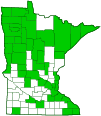oval ambersnail
(Novisuccinea ovalis)
Conservation • Description • Habitat • Biology • Distribution • Taxonomy
|
|
||||||||||||||
Description |
Oval ambersnail is a common, medium-sized, land snail. It occurs in the United States and southern Canada east of the Great Plains. It is common in Minnesota. Oval ambersnail is highly adaptable, occupying a variety of habitats. It is typically found on herbaceous plants near water sources like ditches, streams, and rivers. However, it also thrives in drier environments, including open fields, on grasses, under boards, in leaf mold, and among roadside rubbish. It feeds on fungi, diatoms, and other algae. A recent study suggests that decomposing leaf litter plays a significant role in the diet of amber snails. Adults are 9⁄16″ to ⅝″ (14.2 to 16.5 mm) long and ⅜″ to 7⁄16″ (9 to 11 mm) wide. The shell is thin, fragile, and oval. It has two-and-a-half to almost three whorls. The groove (suture) between the whorls is deep, and the whorls are distinctly rounded. The last whorl (body whorl) above the opening is suddenly and strongly inflated. The remaining whorls are gradually reduced in size, forming a very short, pointed spire. When seen with the tip at the top and the opening facing up, the opening is on the right side. This is referred to as a right-handed shell. The shell color is translucent and pale yellow, greenish yellow, or rarely white. Transverse, wrinkled, growth lines are visible on the surface. The opening of the shell (aperture) is oval and large, occupying about two-thirds the total length of the shell. It is at an angle to the preceding whorls. The lower lip of the aperture is rounded. There is no door-like structure (operculum) covering the opening of the shell. The body is pale with a highly variable amount of gray or black blotches and streaks, which show through the translucent shell. It can vary from almost unmarked to almost entirely dark. There is a pair of upper tentacles on the head with a small eye at the tip of each tentacle, and a pair of smaller sensory tentacles near the mouth. The upper tentacles are dark. There is usually a gray or black stripe on each side of the body, and the tail has a dark patch. The foot is usually orangish. |
Size |
⅝″ (14.2 to 16.5 mm) long |
Similar Species |
Habitat |
Near ditches, streams, and rivers, in open fields, on grasses, under boards, in leaf mold, and among roadside rubbish |
Biology |
Season |
|
Behavior |
|
Life Cycle |
|
Food |
Fungi, diatoms, and other algae; and possibly decomposing leaf litter |
Distribution |
||
|
Sources Laursen, J.R., G.A. Averbeck, and G.A. Conboy. 1989. Preliminary survey of pulmonate snails of central Minnesota. Final report submitted to the Nongame Wildlife Program, Minnesota Department of Natural Resources. Unpaged. Hoagland K. E. & Davis G. M. (1987). "The succineid snail fauna of Chittenango Falls, New York: taxonomic status with comparisons to other relevant taxa". Proceedings of the Academy of Natural Sciences of Philadelphia 139: 465-526. Nekola, J.C. 2002. Distribution and ecology of terrestrial gastropods in Northwestern Minnesota. Final report submitted to the Natural Heritage and Nongame Research Program, Minnesota Department of Natural Resources. 178+ pp. |
|
| 4/4/2025 | ||
|
||
|
||
|
||
|
||
Occurrence |
||
Common |
||
Taxonomy |
|
Class |
Gastropoda (gastropods) |
Subclass |
Heterobranchia |
Infraclass |
Euthyneura |
Subterclass |
Tectipleura |
Superorder |
Eupulmonata |
Order |
Stylommatophora (common land snails and slugs) |
Suborder |
Helicina |
Infraorder |
Succineoidei |
Superfamily |
Succineoidea |
Family |
Succineidae (amber snails) |
Subfamily |
Succineinae |
Genus |
Novisuccinea |
This species was originally placed in the genus Succinea in 1817. In a review of the land Mollusca of North America (Pilsbry, H. A., 1948), the subgenus Novisuccinea was established within the genus Succinea, and Succinea ovalis was included within it. In a review of the Succineidae (amber snails) of Chittenango Falls, New York (Hoagland, K.E., and G.M. Davis. 1987), The subgenus Novisuccinea was raised to full species level. |
|
Subordinate Taxa |
|
|
|
Synonyms |
|
Succinea obliqua Succinea ovalis Succinea ovalis ssp. optima Succinea ovalis var. lineata Succinea ovalis var. pleistocenica Succinea totteniana |
|
Common Names |
|
oval ambersnail |
|
Glossary
Operculum
On mosses: A lid or cover that covers the opening of a capsule and detatches at maturity. On snails: The horny or calcareous door-like structure that seals opening of the shell. On fishes: A bony flap on the rear side of the head that protects the gills.
Visitor Photos |
||
Share your photo of this gastropod. |
||
This button not working for you? |
||
Alfredo Colon |
||
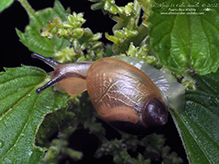 |
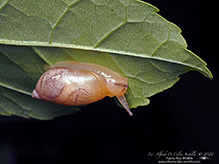 |
|
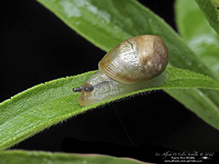 |
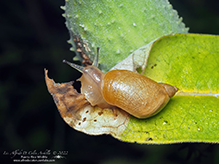 |
|
MinnesotaSeasons.com Photos |
||
|
||
|

Slideshows |
|

Visitor Videos |
||
Share your video of this gastropod. |
||
This button not working for you? |
||
|
Other Videos |
||
OVAL AMBERSNAIL (Novisuccinea ovalis). What is your favorite snail species? |
About
Oct 14, 2022 Oval Ambersnail (Novisuccinea ovalis) are native to North America. They are air-breathing land snails with a simple lung. |
SUCCINEID SNAIL, Novisuccinea ovalis |
About
Feb 23, 2020 SUCCINEID SNAIL, Novisuccinea ovalis |

Visitor Sightings |
||
Report a sighting of this gastropod. |
||
This button not working for you? |
||
Alfredo Colon |
Location: Albany, NY |
 |
Alfredo Colon |
Location: Albany, NY |
 |
Alfredo Colon |
Location: Albany, NY |
 |
Alfredo Colon |
Location: Albany, NY |
 |
MinnesotaSeasons.com Sightings |
||
|

Created: 4/4/2025 Last Updated: © MinnesotaSeasons.com. All rights reserved. |
